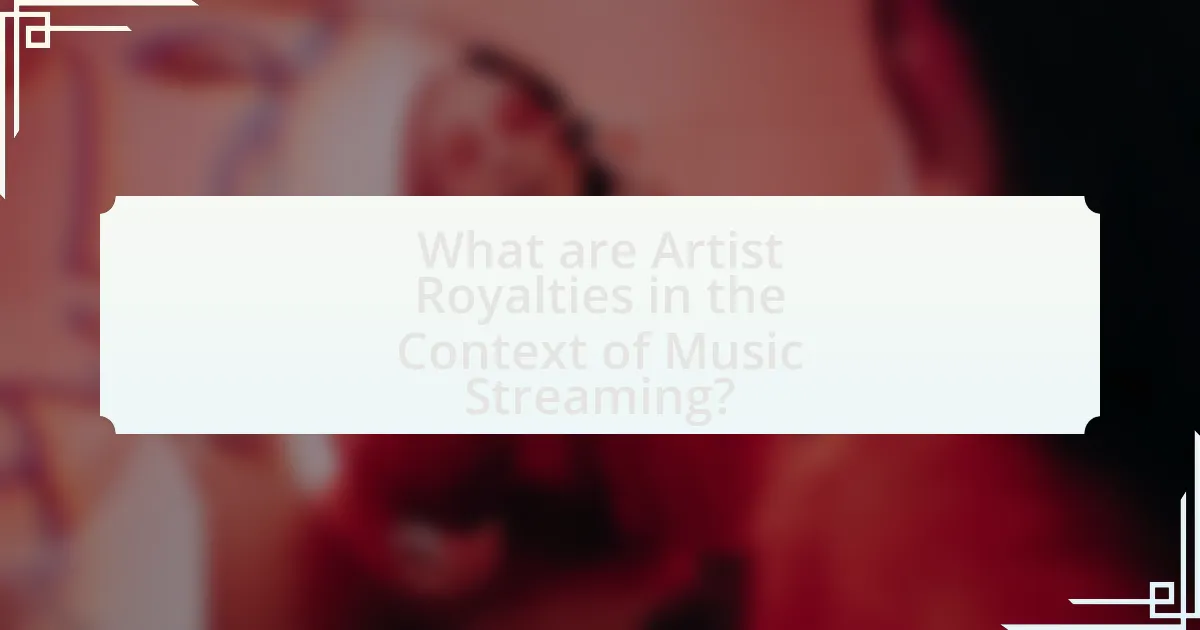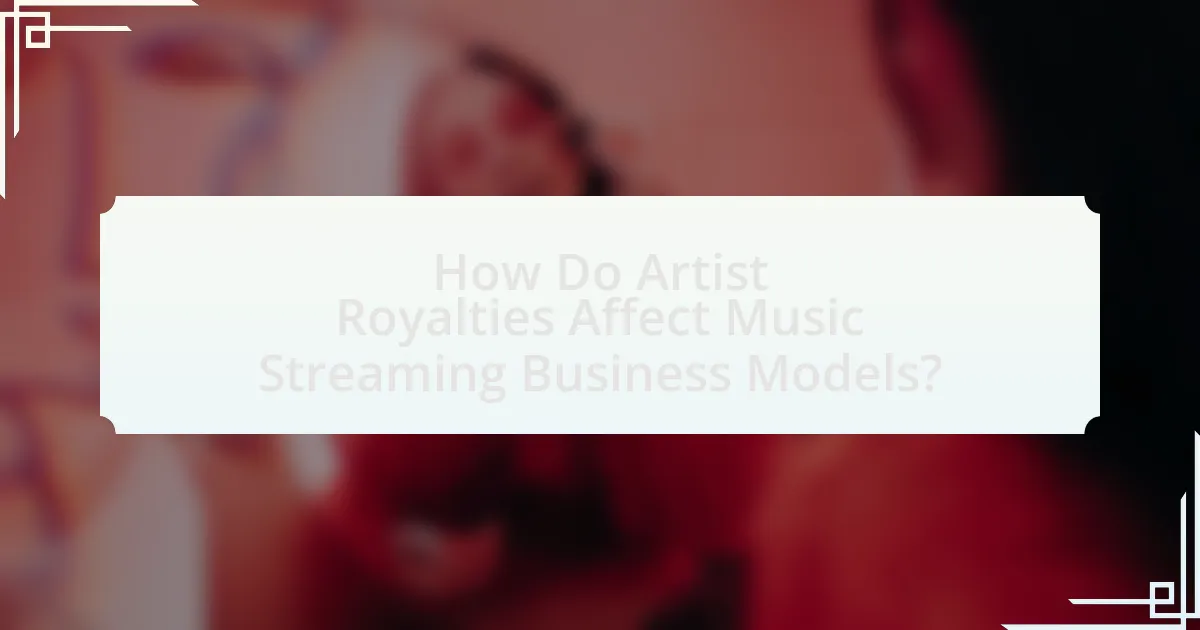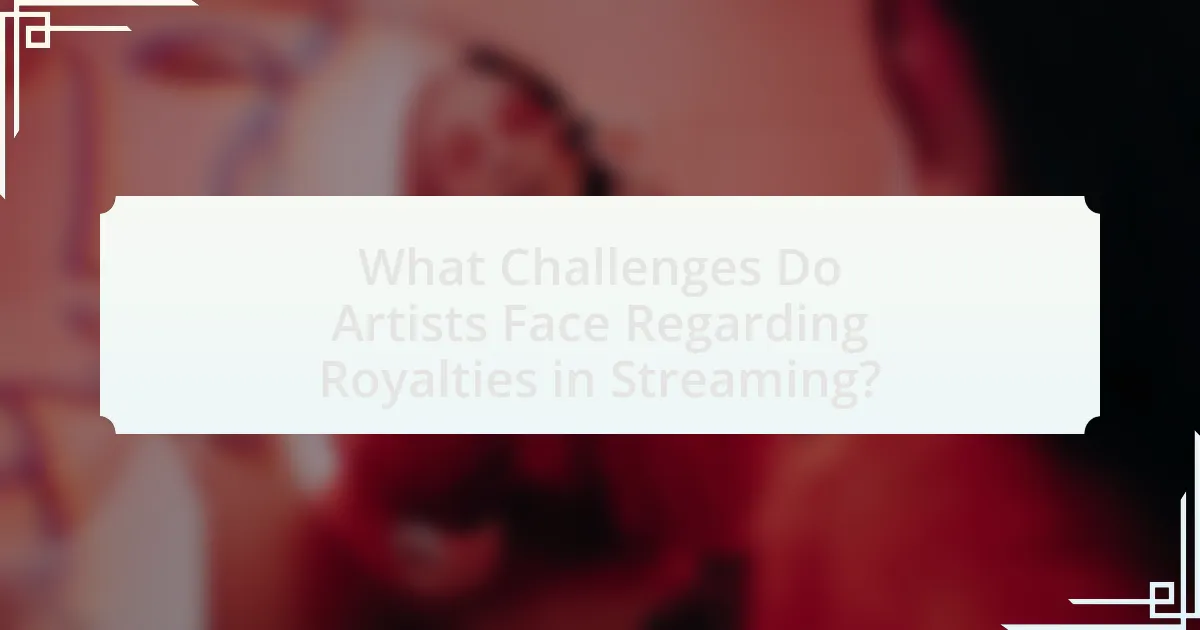Artist royalties are payments made to musicians and rights holders for the use of their music on streaming platforms, calculated based on the number of streams a song receives. This article examines how artist royalties are calculated, the factors influencing these calculations, and the variations across different streaming platforms. It also discusses the importance of royalties for musicians’ income and career sustainability, the impact of royalty structures on streaming business models, and the challenges artists face regarding low payout rates and transparency issues. Additionally, strategies for maximizing earnings and best practices for navigating the complexities of royalties in the streaming landscape are explored.

What are Artist Royalties in the Context of Music Streaming?
Artist royalties in the context of music streaming refer to the payments made to musicians and rights holders for the use of their music on streaming platforms. These royalties are typically calculated based on the number of streams a song receives, with various factors influencing the payout rates, such as the platform’s revenue model and the agreements in place with record labels and distributors. For instance, according to a 2021 report by the International Federation of the Phonographic Industry (IFPI), artists receive a fraction of a cent per stream, which highlights the challenges they face in earning a sustainable income from streaming services.
How are Artist Royalties Calculated in Music Streaming Services?
Artist royalties in music streaming services are calculated based on a pro-rata system, where total revenue generated by the service is divided among rights holders according to the number of streams each artist receives. This means that the more streams an artist accumulates, the larger their share of the total revenue pool. For instance, if a streaming service generates $100 million in a month and an artist’s music accounts for 1% of all streams, that artist would receive 1% of the total royalties distributed, equating to $1 million. This calculation method emphasizes the importance of both the number of streams and the overall revenue generated by the platform, impacting how artists earn from their music in the streaming economy.
What factors influence the calculation of Artist Royalties?
The calculation of artist royalties is influenced by several key factors, including the type of licensing agreement, the distribution model of the streaming service, and the specific terms negotiated between the artist and the label or distributor. Licensing agreements dictate how revenue is shared, while distribution models, such as pro-rata or user-centric, affect the overall payout structure. Additionally, negotiated terms can include advances, recoupable costs, and percentage splits, which directly impact the final royalty amount an artist receives. For instance, in a pro-rata model, royalties are distributed based on total streams, while in a user-centric model, royalties are allocated based on individual user listening habits, leading to different outcomes for artists depending on the model used.
How do different streaming platforms vary in their royalty calculations?
Different streaming platforms vary in their royalty calculations primarily based on their payment structures and user engagement metrics. For instance, Spotify employs a pro-rata payment model, where royalties are distributed based on the total number of streams relative to the total streams on the platform, resulting in varying payouts depending on subscription revenue and user activity. In contrast, Apple Music uses a more straightforward per-stream payment model, offering a fixed rate per stream, which can lead to higher payouts for artists per stream compared to Spotify. Additionally, platforms like Tidal emphasize artist-centric models, providing higher percentages of revenue directly to artists, which can significantly impact overall earnings. These differences in royalty calculations reflect the platforms’ business models and their approaches to artist compensation, influencing how much artists earn from their music.
Why are Artist Royalties Important for Musicians?
Artist royalties are crucial for musicians because they provide a primary source of income from their creative work. These royalties ensure that artists are compensated fairly for the use of their music across various platforms, including streaming services, radio, and live performances. According to the Recording Industry Association of America (RIAA), in 2020, streaming accounted for 83% of the U.S. music industry’s revenue, highlighting the significance of royalties in the digital age. Without adequate royalties, musicians may struggle to sustain their careers, as they rely on these payments to cover production costs, marketing, and living expenses. Thus, artist royalties play a vital role in supporting the livelihoods of musicians and fostering a sustainable music ecosystem.
How do Artist Royalties impact a musician’s income?
Artist royalties significantly impact a musician’s income by providing a primary source of revenue from their recorded music and performances. These royalties are typically generated from various streams, including digital downloads, streaming services, and public performances. For instance, in 2020, the average payout per stream on platforms like Spotify was approximately $0.003 to $0.005, meaning that a musician would need millions of streams to earn a sustainable income. This reliance on streaming royalties highlights the importance of digital platforms in a musician’s financial ecosystem, as traditional sales have declined. Consequently, the structure and distribution of artist royalties directly influence a musician’s overall earnings and financial stability in the evolving music industry.
What role do Artist Royalties play in a musician’s career sustainability?
Artist royalties are crucial for a musician’s career sustainability as they provide a continuous income stream from their creative work. These royalties, which are earned from music sales, streaming, and performances, enable musicians to fund their projects, support their livelihoods, and invest in their careers. According to a 2021 report by the International Federation of the Phonographic Industry, global recorded music revenues reached $23.1 billion, with streaming accounting for 62% of that total, highlighting the significant financial impact of royalties in the digital age. This income allows artists to maintain their artistic output and engage with their audience, ultimately contributing to their long-term viability in the music industry.

How Do Artist Royalties Affect Music Streaming Business Models?
Artist royalties significantly influence music streaming business models by determining how revenue is distributed among artists, labels, and platforms. Streaming services like Spotify and Apple Music allocate a portion of their subscription and advertising revenue to pay artists, typically based on the number of streams their music receives. For instance, in 2021, Spotify reported paying approximately 70% of its revenue to rights holders, which includes artists, songwriters, and record labels. This revenue-sharing model impacts the profitability of streaming platforms and shapes their pricing strategies, as they must balance competitive subscription rates with the need to compensate artists adequately. Consequently, the structure of artist royalties can drive changes in how streaming services operate, including their marketing strategies and the types of content they prioritize.
What are the different business models used by music streaming services?
Music streaming services primarily utilize three business models: subscription-based, ad-supported, and hybrid models. Subscription-based models, exemplified by services like Spotify Premium and Apple Music, generate revenue through monthly fees paid by users for ad-free access and additional features. Ad-supported models, such as Spotify’s free tier, rely on advertising revenue generated from users who listen to music with ads interspersed. Hybrid models combine both approaches, allowing users to choose between a free, ad-supported experience or a premium, ad-free subscription, as seen in platforms like YouTube Music. These models significantly influence artist royalties, as revenue distribution varies based on user engagement and subscription levels.
How do subscription-based models differ from ad-supported models in terms of royalties?
Subscription-based models provide artists with a more predictable and often higher royalty rate compared to ad-supported models. In subscription models, users pay a fixed fee for access, allowing streaming services to allocate a larger portion of their revenue directly to artists, typically resulting in higher per-stream payouts. For instance, reports indicate that artists can earn between $0.006 to $0.0084 per stream on subscription platforms, whereas ad-supported models often yield lower rates, around $0.001 to $0.002 per stream, due to revenue being dependent on advertising income, which can fluctuate significantly. This fundamental difference in revenue generation directly impacts the overall earnings artists receive from their music.
What impact do free trials and promotional offers have on royalty distribution?
Free trials and promotional offers significantly affect royalty distribution by increasing user engagement and subscription rates, which can lead to higher overall revenue for streaming platforms. When users access content through free trials, they often consume more music, resulting in a larger pool of plays that can be monetized once they convert to paying subscribers. According to a report by MIDiA Research, platforms that offer free trials see a conversion rate of approximately 50% to paid subscriptions, which directly influences the royalties paid to artists based on the increased number of streams. Additionally, promotional offers can attract new listeners who may not have otherwise subscribed, further expanding the audience base and enhancing the potential for royalty earnings.
How do changes in royalty rates influence streaming platforms?
Changes in royalty rates directly influence the financial viability and operational strategies of streaming platforms. When royalty rates increase, streaming services may face higher costs, which can lead to reduced profit margins or necessitate price hikes for consumers. For instance, in 2021, the increase in mechanical royalties in the U.S. prompted platforms like Spotify to reassess their pricing models to maintain profitability. Conversely, a decrease in royalty rates can allow streaming platforms to invest more in content acquisition and user experience, potentially attracting more subscribers. Historical data shows that platforms like Apple Music and Spotify have adjusted their business models in response to fluctuating royalty rates, impacting their market strategies and competitive positioning.
What are the potential consequences of increasing or decreasing royalty rates?
Increasing royalty rates can lead to higher earnings for artists, which may incentivize more content creation and improve artist satisfaction. Conversely, decreasing royalty rates can reduce artists’ income, potentially leading to fewer releases and dissatisfaction within the music community. Historical data shows that when Spotify increased its royalty rates in 2018, there was a notable rise in the number of new releases, indicating a positive correlation between higher rates and artist productivity. In contrast, a decrease in rates, as seen in various streaming platforms, often results in artist protests and calls for reform, highlighting the negative impact on their financial stability.
How do streaming services adapt their business strategies in response to royalty changes?
Streaming services adapt their business strategies in response to royalty changes by adjusting pricing models, renegotiating contracts with rights holders, and diversifying revenue streams. For instance, when royalty rates increase, platforms like Spotify and Apple Music may implement subscription price hikes to maintain profitability. Additionally, they often renegotiate licensing agreements to secure more favorable terms or explore partnerships with independent artists to reduce costs. A notable example is Spotify’s introduction of a direct artist payment system, which allows artists to receive a larger share of revenue, thereby attracting more content creators and enhancing their catalog. These strategic adaptations are essential for sustaining their business models in a competitive landscape influenced by fluctuating royalty rates.

What Challenges Do Artists Face Regarding Royalties in Streaming?
Artists face significant challenges regarding royalties in streaming, primarily due to low payout rates and complex distribution models. Streaming platforms typically pay artists a fraction of a cent per stream, with estimates indicating that the average payout is around $0.003 to $0.005 per stream. This low rate makes it difficult for artists to earn a sustainable income, especially for independent musicians who may not have the backing of major labels. Additionally, the revenue is often divided among multiple stakeholders, including record labels, producers, and songwriters, further reducing the amount that reaches the artist. According to a report by the Music Industry Research Association, artists receive only about 12% of the total revenue generated from streaming services, highlighting the financial challenges they face in this model.
How do transparency issues affect artists’ understanding of their royalties?
Transparency issues significantly hinder artists’ understanding of their royalties by obscuring the details of revenue distribution and calculation methods. When streaming platforms and record labels do not provide clear information regarding how royalties are calculated, artists struggle to comprehend the financial implications of their work. For instance, a 2021 report by the Music Industry Research Association highlighted that 70% of artists felt they lacked sufficient information about how their streaming royalties were determined. This lack of clarity can lead to mistrust and confusion, ultimately affecting artists’ ability to make informed decisions about their careers and financial planning.
What are the common misconceptions artists have about their royalties?
Common misconceptions artists have about their royalties include the belief that they receive a significant percentage of streaming revenue directly from platforms, when in reality, they often earn only a fraction of a cent per stream. For instance, reports indicate that artists typically receive between $0.003 and $0.005 per stream from services like Spotify, which can lead to the misunderstanding that their total earnings will be substantial based on high streaming numbers. Additionally, many artists mistakenly think that all royalties are paid directly to them, overlooking that a large portion is distributed to record labels, producers, and other intermediaries before reaching the artist. This distribution model can significantly reduce the amount artists actually receive, leading to further misconceptions about their earnings.
How can artists better track and manage their royalty earnings?
Artists can better track and manage their royalty earnings by utilizing specialized software and platforms designed for royalty management. These tools, such as SoundExchange, TuneCore, and DistroKid, provide real-time tracking of earnings from various streaming services and sales channels. According to a report by the Music Industry Research Association, artists who use these platforms can increase their revenue visibility by up to 30%, as they consolidate data from multiple sources into a single dashboard. Additionally, maintaining accurate records of performances, sales, and licensing agreements further enhances an artist’s ability to manage their royalties effectively.
What are the implications of low royalty rates for the music industry?
Low royalty rates significantly undermine the financial viability of the music industry. When artists receive minimal compensation for their work, it leads to reduced income for musicians, which can discourage creativity and innovation. According to a 2021 report by the Music Industry Revenue, streaming services pay artists an average of only $0.003 to $0.005 per stream, resulting in many artists struggling to make a living. This financial strain can lead to fewer new artists entering the industry, ultimately diminishing the diversity and richness of music available to consumers. Additionally, low royalty rates can create tension between artists and streaming platforms, potentially leading to disputes and calls for reform in how royalties are calculated and distributed.
How do low royalties affect the diversity of music available on streaming platforms?
Low royalties significantly reduce the diversity of music available on streaming platforms. When artists receive minimal compensation for their work, many emerging and independent musicians struggle to sustain their careers, leading to fewer new releases and a reliance on established artists. According to a 2021 report by the UK’s Intellectual Property Office, 70% of musicians reported that low streaming royalties hinder their ability to create new music. This financial strain discourages experimentation and innovation, resulting in a homogenized music catalog dominated by mainstream genres and artists. Consequently, the overall variety of music accessible to listeners diminishes, limiting exposure to diverse sounds and styles.
What strategies can artists employ to maximize their earnings from streaming?
Artists can maximize their earnings from streaming by diversifying their revenue streams, engaging with their audience, and optimizing their music distribution. Diversification includes leveraging merchandise sales, live performances, and exclusive content to supplement streaming income. Engaging with audiences through social media and fan clubs can increase listener loyalty and drive more streams. Additionally, optimizing music distribution by selecting the right streaming platforms and utilizing data analytics to understand listener preferences can enhance visibility and earnings. According to a report by the Music Industry Association, artists who actively promote their music across multiple channels see a 30% increase in streaming revenue compared to those who rely solely on streaming platforms.
What Best Practices Can Artists Follow to Navigate Royalties in Streaming?
Artists can navigate royalties in streaming by understanding their rights, utilizing digital distribution platforms, and actively engaging with their audience. Understanding rights involves familiarizing themselves with copyright laws and the specific terms of their contracts with labels and streaming services. Utilizing digital distribution platforms like DistroKid or TuneCore allows artists to manage their music releases and track earnings efficiently. Engaging with their audience through social media and live performances can increase streaming numbers, directly impacting royalty earnings. According to the Music Industry Research Association, artists who actively promote their work see a significant increase in streaming revenue, highlighting the importance of audience engagement in maximizing royalties.

Leave a Reply